- Recent Updates
- Colpoy's Bay
- Colpoy's Bay Introduction
- Spragge's Hill
- The Kalbfleisch House
- The Kalbfleisch Dock
- The Kalbfleisch Marina
- Whicher's Sawmill
- The Wrecks Near Whicher's Mill
- Frame's Falls and John Wood's Grist Mill
- Albemarle Street
- Hughenden and Whicher's Store
- The Community Hall
- The Forest Home Hotel
- The Colpoy's Bay Schoolhouse
- The Colpoy's Bay Church
- Edgehill Cemetery
- Colpoy's Bay From the Air
- A Glimpse of the Past
- Wiarton
- Berford Street
- Berford St. Part 2
- Berford St. Part 3
- Wiarton Harbour
- Bluewater Beach
- Caframo Ltd. and Wiarton Cement Works
- Wiarton Beet Sugar Factory
- Wiarton's Hotels
- Wiarton's Schools
- Wiarton's Banks
- Grand Trunk Railway Station
- The Wiarton Fish House
- The Wiarton Fish Hatchery
- Wiarton's Berford Theatre
- The Wiarton Woolen Mills
- Wiarton's Furniture Industry
- Wiarton's Hospital
- Wiarton's War Memorial
- Wiarton's Town Hall
- Wiarton's Newspapers
- Wiarton's Grist & Flour Mills
- Wiarton's Sawmill Industry
- Wiarton's Gateway
- Connecting Passages
(Links) - Present-day Map
of Colpoy's Bay - Colpoy's Bay
Lot Map (1870) 
Wiarton Timeline- Present-day Map
of Wiarton - Bibliography
- About the Author
- Site Map
(use if menu doesn't work) - Tell me your impressions!
The Kalbfleisch Marina

Figure 4A: Late evening view of Colpoy's Bay. Looking south from the front yard of the Kalbfleisch house. 1999.
Today, both sides of Colpoy's Bay are significantly more heavily populated than in the past. The vast plots of land awarded in the pioneering days have largely been divided into smaller properties, popular with cottagers as well as permanent homeowners. Figure 4A features a 1999 photo of the bay in which several dwelling lights are visible on the south shore. The present Kalbfleisch dock is visible toward the left of the photo, but you might be wondering what that thing is sticking out of the water a little ways out from the dock. In fact, it is the partial remains of one of two scows (flat bottom barges) sunk around the Kalbfleisch dock to serve as breakwaters for the Kalbfleisch marina/tourist operation.
Edwin Kalbfleisch (my great-grandfather) was a man of many trades. While maintaining the family farm, he ran a business building a variety of wooden boats. To
service these boats, he constructed a dock rivalling the village's main wharf in length. The top image of Figure 4B shows the Kalbfleisch dock in its original state (one of the barges sunk off Whicher's mill is seen at left - see "The Wrecks Near Whicher's Mill"). The largest of Edwin's boats was a solid craft measuring about 40 feet in length, as seen in the bottom left image of Figure 4B. In later years, Edwin shared his boatcrafting skills with his son Frederick
(my grandfather) and operated a marina/tourist operation under the name Kalbfleisch and Sons (see bottom right image of Figure 4B). Visiting tourists were treated to cruising or fishing trips complete with logding at the Kalbfleisch house or cabins on the property.

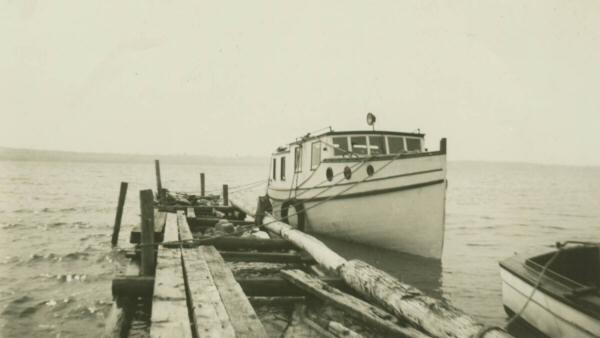
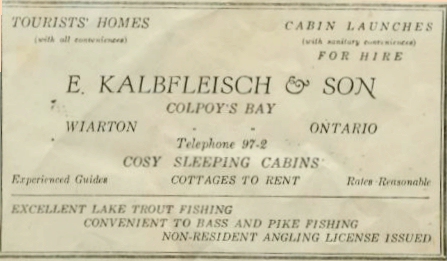
Figure
4B: The original Kalbfleisch dock; Edwin Kalbfleisch's largest boat; Business card for Kalbflesich & sons. Counter-clockwise from top: early-1940s, late 1940s, late 1940s.
In 1955, Frederick took the reigns and established Kalbfleisch Boat Works and Marina, continuing the tourist/fishing charter business as well as offering repairs and mooring for vessels. During the off-season, he continued to ply the boat-craftsman trade, turning out the next and final generation of wooden pleasure craft for a wide variety of customers (including Gordie Tapp of "Hee Haw" television fame).
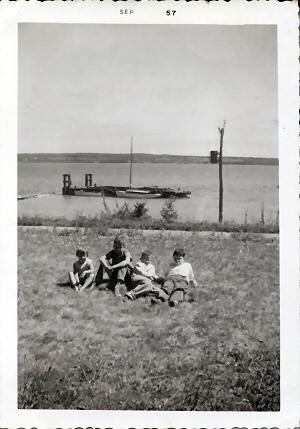 |
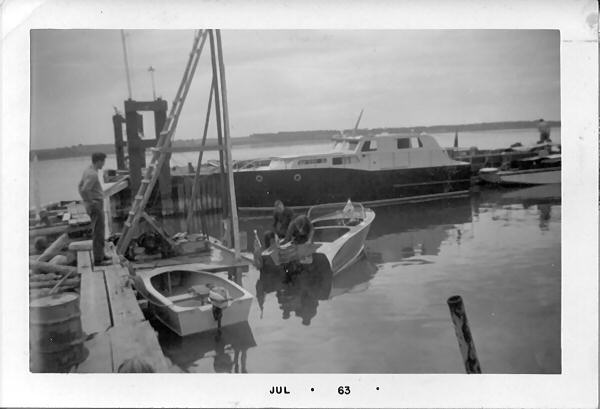 |
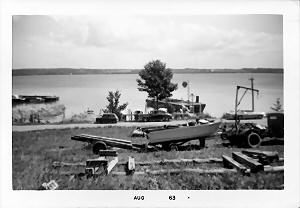 |
Figure 4C consists of three views of the Kalbfleisch marina in it's heyday, complete with a Shell diesel pump visible in the bottom right picture. Looking through these images, one can see the two scows serving their purpose, sheltering the boats in the marina from the waves of the bay. Originally, however, both vessels had served in Wiarton as dredging barges. Massive steampowered buckets would scoop out the soil at the bottom of the harbour and deposit it in these barges for removal click here to see such an operation).
The scow at left in all the images on this page was originally called the Paul H. M. and was purchased for $10 on April 15, 1955 by Fredrick Kalbfleisch from the McNamara Construction Co. of Toronto. It was immediately towed from its berth in Wiarton and sunk in its present position.
When the second scow, visible at right in the bottom right image of Figure 4C, was launched in June of 1951, it was given the utilitarian name of Bermingham Construction Number 3 by its owners, Bermingham Construction Ltd. of Hamilton, Ontario. Fredrick Kalbfleisch purchased the scow about ten years later on the first of March, 1961 for the grand sum of $1. Bermingham had operations out of Wiarton and had already scuttled the barge in the harbour there (hence the bargain basement price!). Immediate removal to Colpoy's Bay village was written in the contract, so my grandfather and a friend raised the scow. He plugged the hole in its bottom with a matress while his friend towed the massive wooden object down the shore with a tiny boat. It was a long process! It was then resunk in its present position.
In 1965 Frederick Kalbfleisch expanded his operations and took possession of the larger marina in Wiarton which he operated until 1968 (see Figure 4D).
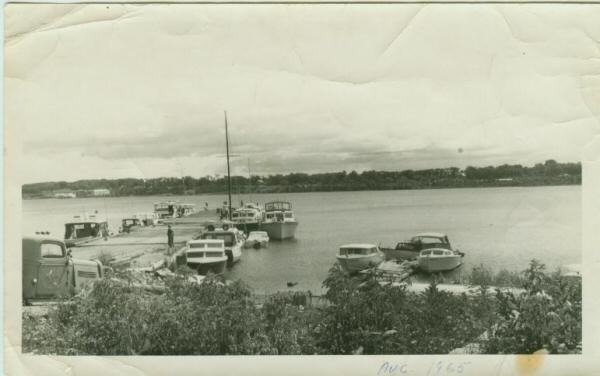
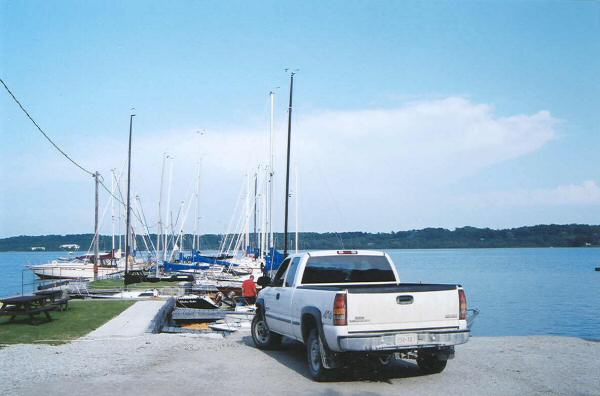

Figure 4D: Kalbfleisch Boat Works and Marina, Wiarton operations c. 1965; a similar view in 2004 and 2023.
Although the operations of Kalbfleisch Boat Works and Marina fell silent many years ago, the foundation of the original Kalbfleisch dock and the nearby remains of the two scows
lie as a reminder of the activity that once surrounded them. (To see some more recent images of the foundation and scows, see the page titled "Glimpse of the Past")
